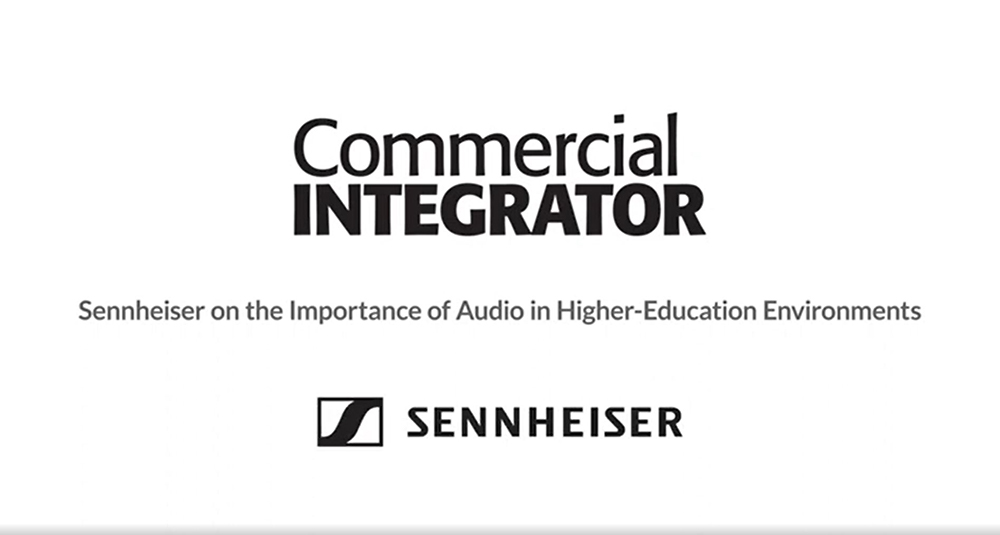CI: Explain why audio is key to higher-ed setups and offer some insights into why it’s sometimes looked past.
David Missall: I think it often is taken for granted — and not only in the higher-ed market. Audio is taken as a last thing to think about, as opposed to video, cameras and room aesthetics. But things really changed drastically when universities were forced into this hybrid-learning experience. They learned that we have this unified communications aspect of learning, but the collaboration was not there. How to include the remote person within the room, and vice versa, was missing. How to make it clear and intelligible, and to make them part of the conversation, was missing.
Those in higher-ed were forced to reevaluate how to do audio. They’d think, “How am I going to pick up every student, if they have a question, so the remote person can listen?” That became a bigger issue. For example, think of music students; now, they’re learning remotely. So, we have to make sure the audio is correct. It could be the music you’re playing back and forth, or it could be someone at the far end of the room who may not be close to the microphone or be on-microphone. How are they going to get their point across so that the person remotely can hear it properly?
So, I think higher-ed really started to consider how they could do this better. They started to consider how they could be inclusive to everyone in the classroom — both in-person and remote — so that everyone feels part of the learning experience. A big part of that is audio…understanding everything, not missing anything and ensuring everything is very intelligible. It should be easy for people to get their point across. So, technology managers and facility designers began to rethink their approach to how they’re going to make that work. They learned from it. It forced them to embrace that different perspective.
CI: Let’s discuss some of Sennheiser’s most powerful technologies. Would you like to start with TeamConnect Ceiling 2?
Missall: What you see is a really big shift toward automation and easy setup — especially in the classroom technology for the professor — along with inclusivity. The TeamConnect Ceiling 2 ceiling microphone is a mic array. It has automatic, beam-forming functionality as part of the array to automatically go to whoever is speaking in the room. The professor doesn’t have to touch anything. They can walk into a room, not have to put a microphone on and be anywhere in the room. The TeamConnect Ceiling 2 will automatically pick them up. If somebody asks a question, the beam will automatically go to the person in the audience and pick them up. The person on the remote side hears everyone in the room equally, regardless of where they’re sitting, and they hear the professor, regardless of where they’re standing. So, they don’t have to adjust gain of a transmitter. They don’t have to think about where they’re standing in relation to the microphone. It just makes it a lot easier.
CI: Tell us about the value proposition of SpeechLine Digital Wireless.
Missall: The more traditional wireless microphones are still being used extensively. Sennheiser offers our SpeechLine Digital Wireless systems. Now, you’re going to use the mic…you’re going to have a beltpack on you…maybe a handheld with you. But we’ve done a lot with SpeechLine to make it automated.
You don’t have to do frequency coordination because it uses DECT technology. So, it automatically picks frequencies for you and actively will move within a certain spectrum so that you’re never going to get interference. The beltpack and the handheld don’t have gain control. So, regardless of whether you’re a soft speaker or a loud speaker, it’s going to compensate for that and you’re not going to overload or underpush the microphone itself. So, if the professor puts the lavaliere lower, that’s OK. If it’s too high, that’s all right. If they’re too close to the mic, it doesn’t matter. And frequency coordination isn’t a thought, either.
So, we tried to automate these things and make it a lot easier for the professor. With SpeechLine, we also made it networkable so that there is control and monitoring of all devices across a campus. Because it must be easy for the facility manager and the guy who’s doing the service, so he can monitor and make sure everything is working from room to room. SpeechLine Digital Wireless has a lot of technology under the hood for ease of use for the end user, and ease of workflow for facility management.










